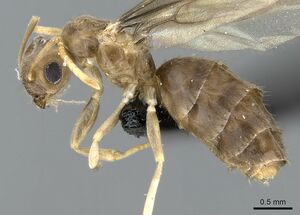Paraparatrechina luminella
| Paraparatrechina luminella | |
|---|---|

| |
| Scientific classification | |
| Kingdom: | Animalia |
| Phylum: | Arthropoda |
| Class: | Insecta |
| Order: | Hymenoptera |
| Family: | Formicidae |
| Subfamily: | Formicinae |
| Tribe: | Lasiini |
| Genus: | Paraparatrechina |
| Species: | P. luminella |
| Binomial name | |
| Paraparatrechina luminella LaPolla & Fisher, 2014 | |
This species has been collected from nests in rotten logs, under rootmasses and in the ground - all in forested habitats.
Identification
LaPolla and Fisher (2014) - Very distinct patches of lighter areas (ranging from yellow to white) on pronotum (that can extend onto mesonotum) and gastral tergites (typically from posterior of T1 through anterior portion of T4.)
Compare with: Paraparatrechina albipes. The coloration pattern seen in the worker of Paraparatrechina luminella is very distinct and is unlike any pattern seen in other species from either the Afrotropical or Malagasy regions. The most similar coloration pattern among Paraparatrechina is seen in P. albipes, in which workers typically have a light patch of whitish coloration on the posterior pronotum and mesonotum that contrasts with the generally overall dark brown color of the body. Whether this is indicative of a close relationship between these two species or is simply convergence is unclear.
Keys including this Species
Distribution
Latitudinal Distribution Pattern
Latitudinal Range: -4.48213° to -4.65284°.
| North Temperate |
North Subtropical |
Tropical | South Subtropical |
South Temperate |
- Source: AntMaps
Distribution based on Regional Taxon Lists
Malagasy Region: Seychelles (type locality).
Distribution based on AntMaps
Distribution based on AntWeb specimens
Check data from AntWeb
Countries Occupied
| Number of countries occupied by this species based on AntWiki Regional Taxon Lists. In general, fewer countries occupied indicates a narrower range, while more countries indicates a more widespread species. |

|
Estimated Abundance
| Relative abundance based on number of AntMaps records per species (this species within the purple bar). Fewer records (to the left) indicates a less abundant/encountered species while more records (to the right) indicates more abundant/encountered species. |

|
Biology
Castes
Images from AntWeb
    
| |
| Queen (alate/dealate). Specimen code casent0159313. Photographer Estella Ortega, uploaded by California Academy of Sciences. | Owned by CAS, San Francisco, CA, USA. |
   
| |
| Holotype of Paraparatrechina luminella. Queen (alate/dealate). Specimen code casent0159693. Photographer Estella Ortega, uploaded by California Academy of Sciences. | Owned by CAS, San Francisco, CA, USA. |
 
| |
| Paratype of Paraparatrechina luminella. Worker. Specimen code casent0159944. Photographer Michele Esposito, uploaded by California Academy of Sciences. | Owned by CAS, San Francisco, CA, USA. |
   
| |
| Worker. Specimen code casent0160868. Photographer Estella Ortega, uploaded by California Academy of Sciences. | Owned by CAS, San Francisco, CA, USA. |
Nomenclature
The following information is derived from Barry Bolton's Online Catalogue of the Ants of the World.
- luminella. Paraparatrechina luminella LaPolla & Fisher, 2014: 146, figs. 10-15 (w.q.) SEYCHELLES.
Unless otherwise noted the text for the remainder of this section is reported from the publication that includes the original description.
Description
Worker
(n=8) TL: 1.37–1.58; HW: 0.38–0.46; HL: 0.44–0.47; EL: 0.11–0.13; SL: 0.45–0.50; PW: 0.20–0.29; WL: 0.46–0.52; GL: 0.46–0.67 Indices: CI: 85–98; REL: 25–28; SI: 108–124;
Overall brown with patches of yellow to white; lighter area medially between eyes and above torulae; distinct patches of lighter areas (ranging from yellow to white) on pronotum (that typically extends onto mesonotum and occasionally onto dorsal face of propodeum) and gastral tergites (typically from posterior of T1 through anterior portion of T4; scapes proximally more brown becoming yellow to whitish midlength, lightening to white through apex of funiculus; procoxae golden yellow, meso/metacoxae and trochanters white; femur golden yellow then remainder of leg light yellow to white; body covered in dense, appressed pubescence; macrosetae placement as is typical in Paraparatrechina. Head ovate with nearly straight posterior margin; scapes surpass posterior margin by first 2-3 funicular segments; three ocelli apparent. Mesosoma compact with steeply rising pronotum in lateral view; mesonotum and metanotal area short; metanotal area indistinct, only slightly impressed; propodeum with short, flat dorsal face and much longer, steep declivitous face.
Queen
Measurements (n=3) TL: 3.34–3.75; HL: 0.61–0.63; HW: 0.66–0.69; EL: 0.25–0.26; SL: 0.61–0.62; PW: 0.66–0.74; WL: 1.13–1.22; GL: 1.52–2.02 Indices: CI: 104–111; REL: 39–41; SI: 91–92
As in worker, with modifications expected for queen caste and the following differences:
1. Coloration overall more brown than in worker, with no distinct yellow to white patches on mesosoma or gaster; lighter antennae and legs.
2. Head subcordate.
3. Legs generally as in worker, except coxae brown.
Type Material
Holotype. SEYCHELLES: Silhouette Island, above Jardin Marron on crest to Mont Plaisir and Pot a Eau, 520m, 4.4867°S, 55.2341°E, 20.i.2010, forest, rotten log, B.L.Fisher et al. CASENT0159693 (California Academy of Sciences); paratype worker, same locality as holotype (National Museum of Natural History); 2 paratype workers, SEYCHELLES: Mahe Island, Mont Copolia, 520m, 4.65121°S, 55.45835°E, 8.ii.2010, forest, sifted litter, B.L.Fisher et al. CASENT0159361 (CASC), CASENT0159373 (CASC); paratype worker, SEYCHELLES: Mahe Island, Le Niol, 345m, 4.63067°S, 55.43159°E, 11.ii.2010, tree plantation, rotten log, B.L.Fisher et al. CASENT0159051 (CASC); paratype worker, SEYCHELLES: Mahe Island, Casse Dent, Morne Seychellois National Park, 465 m, 4.65284°S, 55.43735°E, 11.ii.2010, mixed forest, under rootmat, B.L.Fisher et al. CASENT0145383 (CASC); paratype worker, SEYCHELLES: Silhouette Island, below Mont Cocos Marrons, 320m, 4.50248°S, 55.24395°E, 21.i.2010, forest, under rootmat, B.L.Fisher et al. CASENT0158936 (CASC); paratype worker, SEYCHELLES: Silhouette Island, on ridge toward Pot a Eau, 600m, 4.48213°S, 55.23408°E, 22.i.2010, moist rainforest, rotten log, B.L.Fisher et al. CASENT0158939 (CASC); paratype worker, SEYCHELLES: Silhouette Island, Jardin Marron, 395m, 4.48636°S, 55.23627°E, 27.i.2010, non-native forest, on low vegetation, B.L.Fisher et al. CASENT0159308 (CASC); paratype worker, SEYCHELLES: Silhouette Island, on ridge toward Mont Corgat, 445m, 4.49537°S, 55.23946°E, 25.i.2010, forest, ground nest, B.L.Fisher et al. CASENT0159944 (CASC); paratype worker & queen, SEYCHELLES: Silhouette Island, ridge from Mont Corgat to Mont Cocos Marron, 455m, 4.50126°S, 55.23985°E, 24.i.2010, forest, rotten log, B.L.Fisher et al. CASENT0159905 (USMN).

